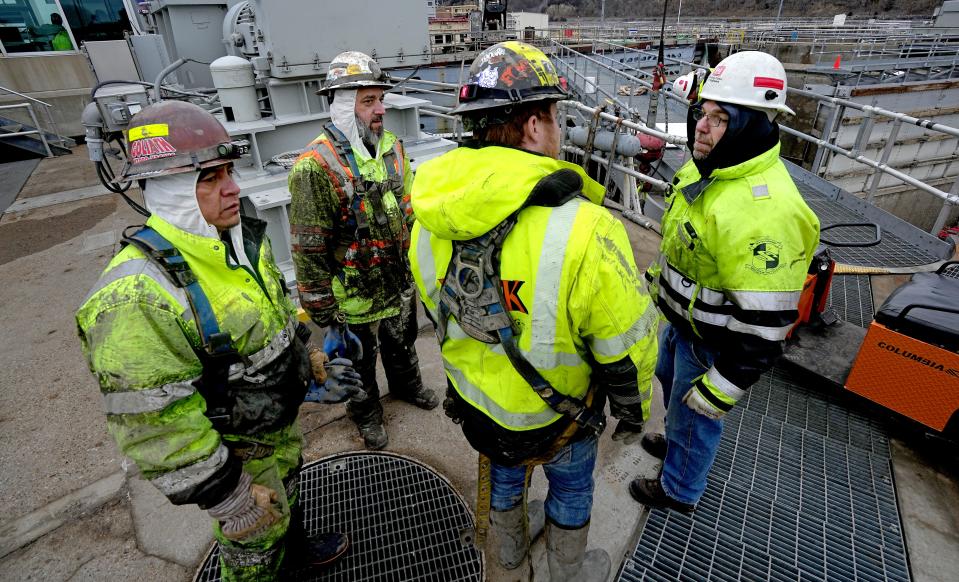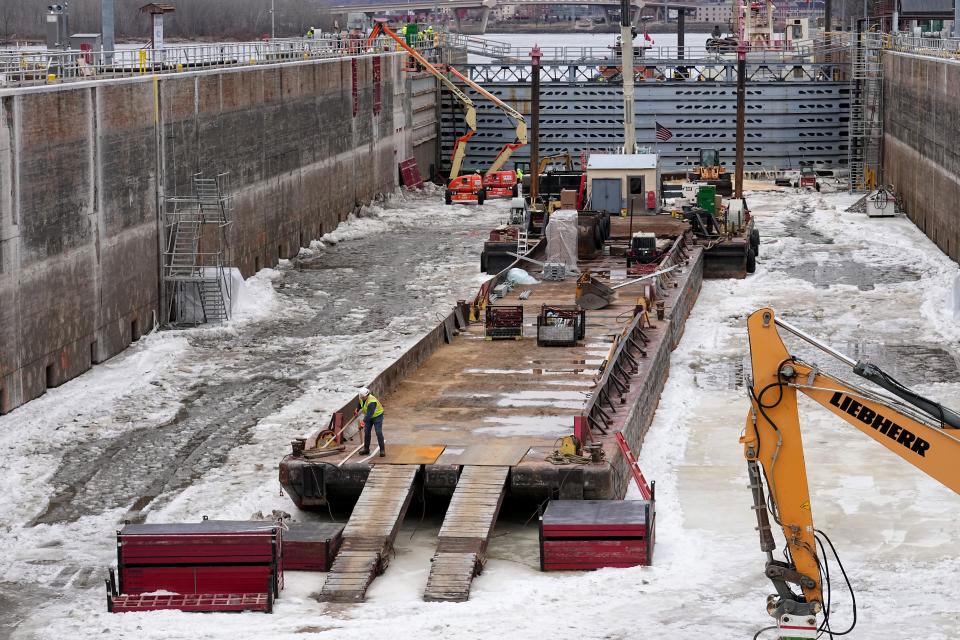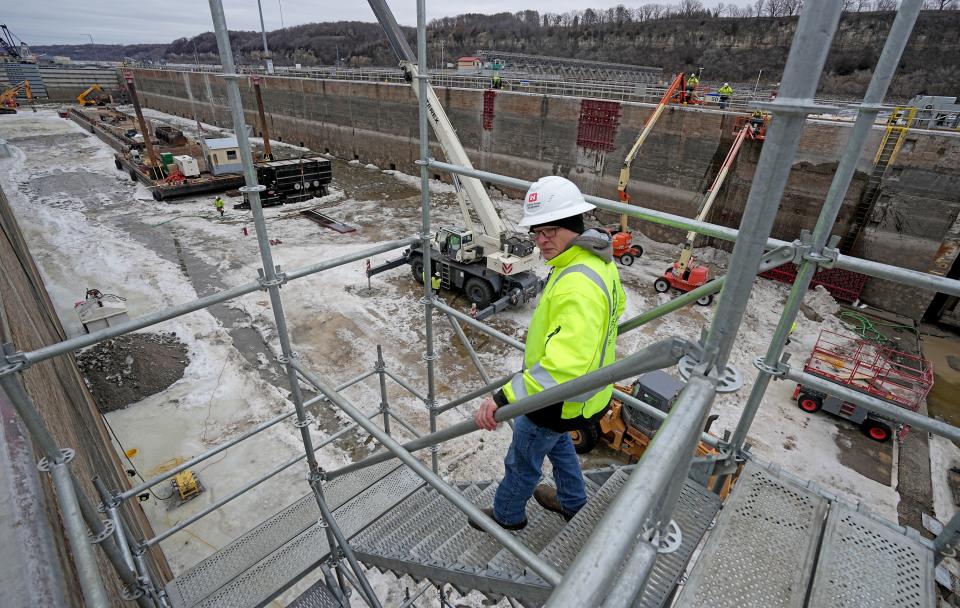A barge, a bulkhead and $3.3 million: How the Mississippi River's locks and dams stay in ship shape
HASTINGS, Minnesota - The locks and dams on the Mississippi River are massive feats of engineering, nearing 100 years old. They shepherd millions of tons of goods each year, acting as water-based elevators to lift boats and barges up or down to the next section of river. A single lock gate weighs 268,000 pounds.
So what happens when they need a facelift?
The U.S. Army Corps of Engineers, which cares for the structures, has to go to great lengths to get a good look at what repairs need to be made.
Each lock is drained about every 20 years for maintenance and inspection. It's a multimillion-dollar project called "dewatering" that takes months from planning to execution. And it comes with a looming deadline: the opening of shipping season on the upper Mississippi — this year, March 5 — which closes to barge traffic during the winter because of ice and snow.
More: Here's how the locks and dams on the Mississippi River work, and why they exist
This season, it was Lock and Dam 2's turn, which has guided an average of 6 million tons of goods up and downriver annually over the past three years. Located near Hastings, Minnesota, the structure was built in 1948, making it one of the younger of the locks and dams on the upper Mississippi. Its concrete walls, worn down by decades of freeze-thaw cycles, needed some upkeep, and some other minor repairs and inspections.
The last time Lock and Dam 2 was dewatered was winter 2007. That was Army Corps maintenance and repair foreman Mike Gunderson's first time dewatering a lock. He spoke with a Journal Sentinel reporter and photographer Tuesday as workers milled around the 600 foot-long chamber, clad in fluorescent yellow safety vests, the magnitude of the lock's parts dwarfing them.

That first time, "I called my wife and said, 'I don't know if I'm ready for this,'" Gunderson recalled, gesturing to the massive construction site unfolding before him.
Now it's old hat for him — but it's still a big deal.
How does the Corps 'dewater' a lock?
The planning process began almost a year in advance to figure out what needed to be fixed and secure funding, said Steve Heidbrider, lockmaster for Lock and Dam 2. This year, shipping season ended Dec. 5 and the dewatering crew got to work on the $3.3 million project.
They set up bulkheads on each end — giant gray slabs that stopped the river from pouring into the lock chamber — then pumped the existing water out. It took about 30 hours to completely dewater the chamber, Heidbrider said.

After that, a small pump was set up to run constantly, preventing water that squeezed past the bulkheads from filling the chamber. It's a reminder of the river's strength.
"We don't stop the Mississippi River," Gunderson said. "We just slow her down."
The heavy duty equipment needed to perform maintenance was floated into the chamber on a barge and sunk to the bottom as the chamber was drained. It will remain there until the equipment is ready to be carried out again.

Once the water was out, workers scraped the bottom for debris, zebra mussels and other small items that have collected over time. This year, Heidbrider said, a $1,500 boat propeller was uncovered and eventually returned to its owner.
Then, the real work began. On Tuesday, it was all on display.
Lifted by a crane, a crew member washed the lock wall to prepare for concrete repairs, in which studs will anchor new concrete over the old. Others jacked up the lock's hefty new gates, which were installed three years ago, to make sure they were functioning properly. They were also getting ready to repair and replace the gates' pintle balls, which act as hinges.

While doing that maintenance, workers also checked for anything else that might be wrong with the lock on parts they wouldn't have seen since 2007.
"As much as we know above water, we don't know what's happening below the water until we get it dewatered," Heidbrider said.

And although temperatures at the end of January were mild, the crew was slowed by snow and frigid cold mid-month, which coated much of the lock chamber with ice.
More: As Mississippi River swings between historic highs and lows, shipping industry struggles to adapt
It's Heidbrider's first dewatering project. His dog, Molly, sometimes joins him at the site. But she stays tucked away when he climbs down the metal stairs into the bottom of the chamber, essentially leaving him standing at the bottom of the Mississippi River — an opportunity that won't come around again for him soon.

He's relatively unfazed by the vastness of the work occurring around him.
"It's pretty simple stuff," he said. "It's just big."
About the Mississippi River's locks and dams
The locks and dams were installed nearly a century ago on the upper Mississippi River so that boats hauling freight up and down the river could have easier passage.
Today, the upper river is divided into sections called pools, where a fixed amount of river is held back by a dam. Each corresponding lock acts like an elevator, bringing boats up or down to the water level of the next pool. Another analogy would be a staircase of water that boats and barges climb and descend.
More: Mississippi River lock-and-dam system is outdated and in disrepair. What if it fails?
The Army Corps operates 29 locks and dams on the upper Mississippi River, from Minneapolis to Granite City, Illinois, north of St. Louis. The lower Mississippi does not need locks and dams because the river becomes deep and wide enough to naturally accommodate shipping as large tributaries, like the Missouri and Ohio rivers, join up with it.
Next year, a different lock and dam will be the focus. A different crew will be pushing against the clock.
For now, Heidbrider said, the focus is on getting all the work done in time to remove the bulkheads at Lock and Dam 2 by the end of the month. To meet their deadline, it's likely the crew will be working weekends to make everything come together so shipping season can open without a hitch.
Madeline Heim is a Report for America corps reporter who writes about environmental issues in the Mississippi River watershed and across Wisconsin. Contact her at (920) 996-7266 or mheim@gannett.com.
Please consider supporting journalism that informs our democracy with a tax-deductible gift to this reporting effort at jsonline.com/RFA or by check made out to The GroundTruth Project with subject line Report for America Milwaukee Journal Sentinel Campaign. Address: The GroundTruth Project, Lockbox Services, 9450 SW Gemini Dr, PMB 46837, Beaverton, Oregon 97008-7105.
This article originally appeared on Milwaukee Journal Sentinel: Army Corps dewaters Mississippi River lock in Minnesota for repairs

